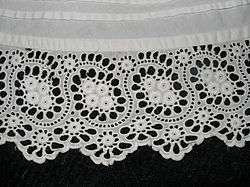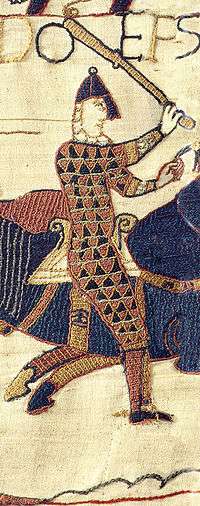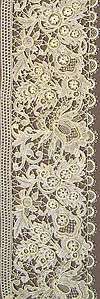Cutwork

Cutwork or cut work, also known as Punto Tagliato in Italian, is a needlework technique in which portions of a textile, typically cotton or linen,[1] are cut away and the resulting "hole" is reinforced and filled with embroidery or needle lace.
Cutwork is related to drawn thread work. In drawn thread work, typically only the warp or weft threads are withdrawn (cut and removed), and the remaining threads in the resulting hole are bound in various ways. In other types of cutwork, both warp and weft threads may be drawn.
Needlework styles that incorporate cutwork include Broderie Anglaise, Carrickmacross lace, whitework, early reticella, Spanish cutwork, Hedebo,[2] and Jaali which is prevalent in India.
History
This technique originated from approximately 14th, 15th, and 16th century Italy at the same time as the Italian Renaissance.[3] Additionally in the Elizabethan era, cutwork was incorporated into the design and decoration of some ruffs. In a fashion sense, this type of needlework has migrated to countries around the world,[4] including the United Kingdom, India, and United States. Cutwork is still prevalent in fashion today, and although different, is commonly mistaken for lace. The eyelet pattern is one of the more identifiable types of cutwork in modern fashion.
Hand cutwork
This form is the most traditional form of cutwork. Here, areas of the fabric are cut away and stitch is applied to stop the raw edges from fraying.[5]
Laser cutwork
This form of cutwork allows for more precise and intricate patterns to be created. The laser also has the ability to melt and seal the edges of fabric with the heat of the laser. This helps against fabric fraying during the creation process.[5] Additionally, using a laser for cutwork enables the embroider or creator to achieve unique designs such as an ‘etched look’ by changing the depth of the laser cut into the fabric.
References
- ↑ http://www.wisegeek.com/what-is-cutwork-embroidery.htm
- ↑ http://www.merriam-webster.com/dictionary/hedebo
- ↑ http://www.britannica.com/EBchecked/topic/147612/cutwork
- ↑ http://articles.timesofindia.indiatimes.com/2013-08-22/trends/35347497_1_embroidery-jatin-varma-technique
- 1 2 Richard Sorger; Jenny Udale (1 October 2006). The Fundamentals of Fashion Design. AVA Publishing. pp. 83–. ISBN 978-2-940373-39-0.
- Virginia Churchill Bath, Needlework in America, Viking Press, 1979 ISBN 0-670-50575-7
- S.F.A. Caulfield and B.C. Saward, The Dictionary of Needlework, 1885.



